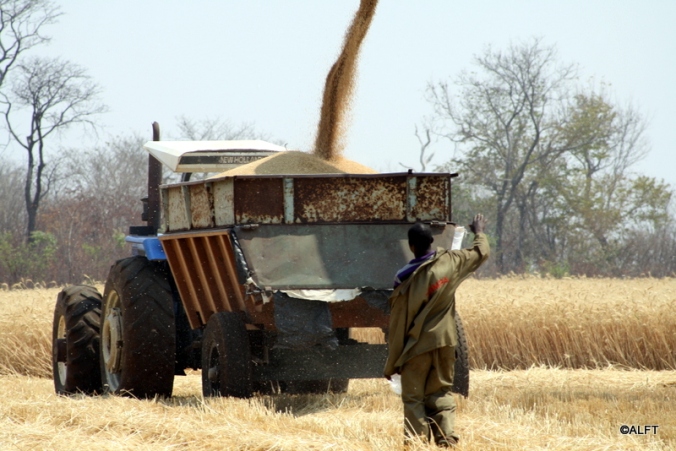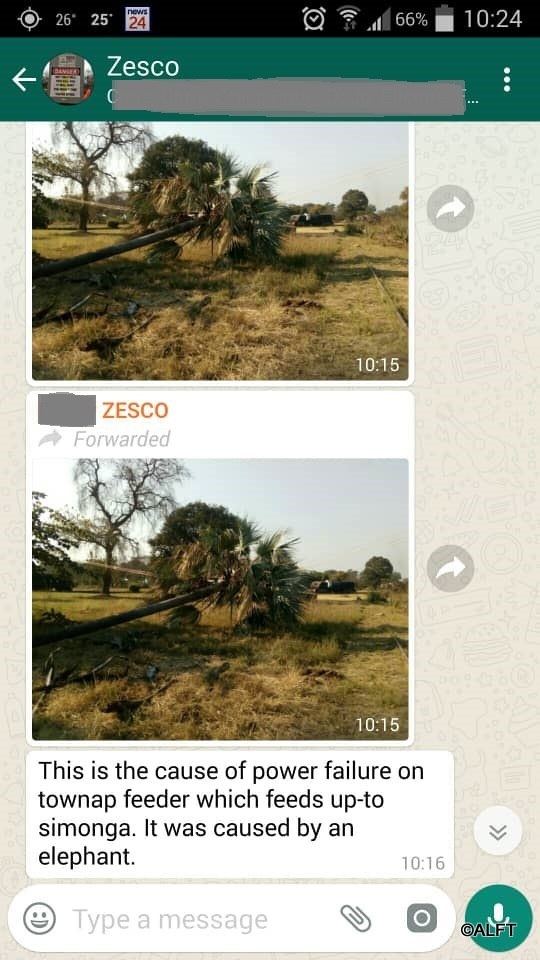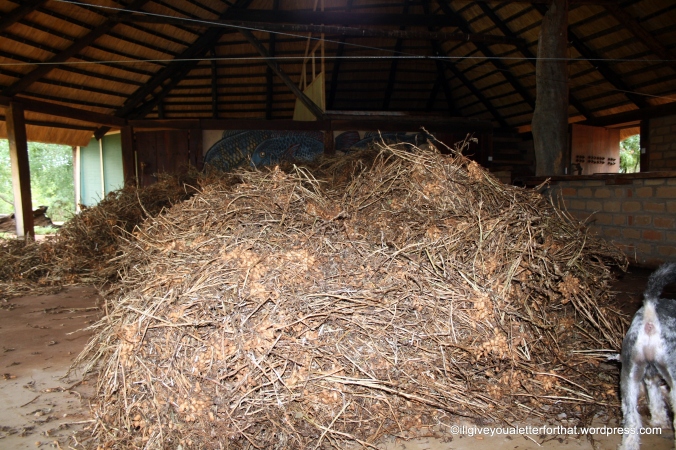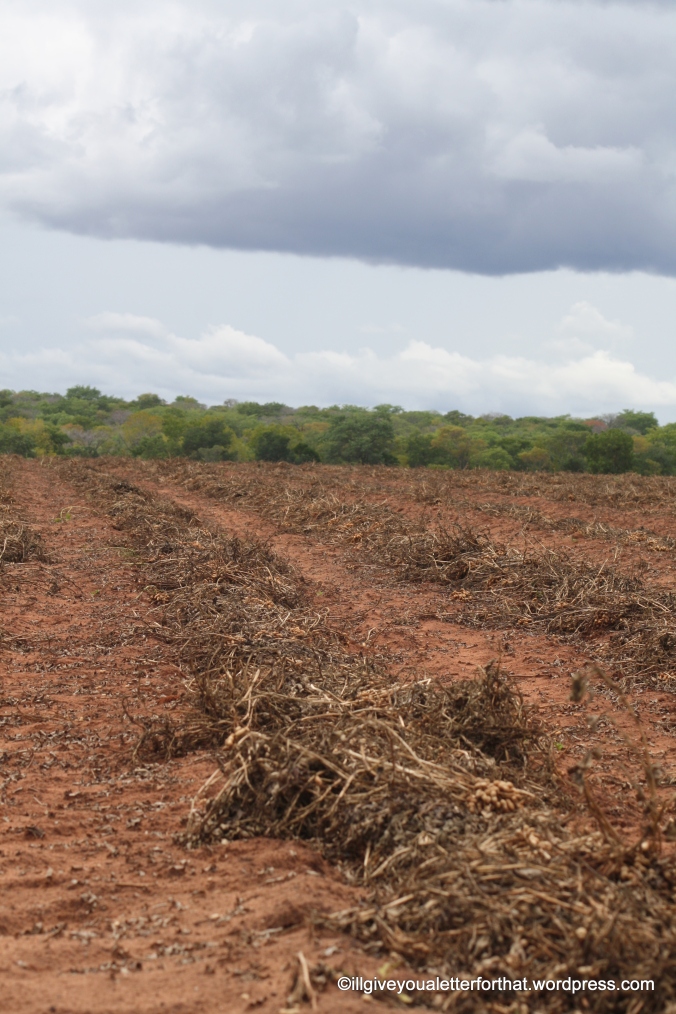










Silent Sunday Stills

We are now on the warmer side of winter; nights are not as cold and days are getting longer. There is not long to go until the wheat starts to senesce and we begin preparing for harvest.

We have not had any rainfall since March and it’s pretty dry, so until the drying out period for the wheat begins it’s important that we keep on top of our irrigation program.

Power outages are normal around here. They happen almost daily and although we usually receive notification in advance, they can be quite disruptive to farming operations. When we woke up to no electricity this morning – with no prior warning – Piet contacted our local electricity supply company (ZESCO) who told him that power was out for maintenance. He then posted a question on the WhatsApp ZESCO chat group and got this response:

Which was quickly amended to:

Having elephants as neighbours can be rather trying at times!

It’s rained so much the soya-beans dropped by the combine harvester have started to germinate – the resilience of life never ceases to amaze me.





Pop over to Lindaghill’s blog to see more One-Liner Wednesday posts.
This year has been a very dry one for us. Our records show we have only received 245mm of rainfall. Compared to last year’s 1,500mm that’s abysmal, and it would have been a disaster farming-wise if we weren’t able to draw water from the Zambezi River for irrigation.
But dry weather makes ideal harvesting weather and we started lifting soya beans by hand last week in anticipation of the combine arriving on Monday to finish the job.
Our peanut crop was also ready for harvest and so last week it was all systems go! The ‘new’ second-hand peanut harvester we bought earlier this year and the tractors had been serviced, 50 extra hands had been hired and Piet was up before light, doing last-minute checks and reminding everyone of their duties.
Within minutes Piet realised something was amiss with the peanut harvester. It was blocking up with nuts and debris and just not doing the job properly. And so the frustrations began, and continued throughout the week and over the weekend.
Piet and the farm mechanic tinkered and tapped, removed parts, cleaned and then replaced them. They swore (a little), paced and scratched their heads. And they sweated! Temperatures (and tempers) were rising and clouds started forming on the horizon.
Eventually, on Monday, Piet conceded defeat, phoned around a bit and with a lot of perseverance and a little luck found a mechanic who specialises in fixing peanut harvesters – we are expecting him to fly in from Johannesburg today.
On Tuesday morning Piet realised that rain was inevitable, so he arranged to have some of the harvested nuts moved into our old managers house (our sheds are too full with next season’s fertilizer) where they would stay dry – the mechanic will need some dry material to test the machine with. Normally the harvested nuts are windrowed and left to dry in the fields – because it is normally dry at this time of year.
Then on Tuesday afternoon those clouds rolled in and it started raining. And it rained. And rained. And rained. It rained all through the night and only stopped at around 10 o’clock this morning, April 1st.

The offending peanut harvester hiding in shame

Come on in – grab yourself some peanuts

A pile of (dry) peanuts.

These are not so dry

Soggy windrows – and it’s threatening to rain again …

Waiting for a sunnier day
Certainly an April Fools Day for us, although not a particularly funny one.
The Daily Post Weekly Photo Challenge – Silhouette
Photography is all about experimenting with light, and then positioning yourself (or your subject) in the right spot to achieve a certain effect. One such effect is a silhouette, in which an outline of someone or something appears dark against a lighter background. Silhouettes can be very dramatic and resemble black shapes without any details, but the effect varies from picture to picture.
When Piet first arrived here nine years ago the farm now known as Sitikela was bush. Thick, solid, tangled, dry bush. And it was brown. The trees were brown, the grass was brown, the leaves scattered on the sand were brown – even the sand was brown.
As he drove up a sandy, unkempt track he noticed the top of a solitary tree towering above the rest of the forest – and it was green! Although it was mid-winter, the heat of the day was almost unbearable and the shade of this tree looked like a likely spot to set up camp; Piet and Sarel, his business partner, lived in tents under that tree for two years while they set to work developing the farm and today our house nestles comfortably in that same shade.
Guibourtia coleosperma, also known as Rhodesian Copalwood, African Rosewood and Large False Mopane is a beautiful, mostly evergreen tree which occurs almost exclusively on Kalahari sand. The tree is ubiquitous on our farm and we have at least ten growing in our garden. Our offices are also built under the shade of one of these magnificent specimens.
I love the varying textures of the bark, smooth, cracked, knotty.
The paired leaves look similar to those of the Mopane tree (Colophospermum mopane) which also occurs in this area and it is easy to understand why this tree is sometimes called the Large False Mopane.
The bright red arils, although somewhat tasteless, are edible and the indigenous people pound them into a flour which they cook into a nutritious meal; they do the same with the seeds and I have read somewhere that this has saved many lives in times of famine.
Of course birds love the seeds and arils too, and we are often entertained by the raucous shouting of trumpeter hornbills, sounding uncannily like crying babies as they skirmish and scuffle for the juiciest ones.
Guibourtia coleosperma is a much sought-after hardwood. When first cut the timber has a unique pinkish-brown colour which later changes to a rich, warm, edible-looking dark chocolate-brown.
I have a farm in Africa.
Well, I don’t but Piet does, although to be quite correct, he doesn’t have a farm, he leases it – as does every farmer in this part of the world.
It is a 560Ha farm, split into two sections; one large one and one small. The larger section, which we have named Sitikela Farm (sitikela means roller – a beautiful, colourful bird which occurs in this area – in Lozi), sits proudly on top of ancient sand dunes, blown in from the Kalahari Desert over millennia and boasts panoramic views of the mighty Zambezi River. In some places you can even see on the horizon the mist rising high and billowing cloud-like from the Mosi oa Tunya (or Smoke That Thunders), more commonly known as the Victoria Falls, one of the Seven Wonders of the World.

This picture was taken some years ago – now this magnificent view is marred by an ugly cellphone tower.
Photo credit: Piet
The second, smaller section is about 7km away, situated on the banks of the Zambezi River.
During the winter months we grow wheat and seed-maize (corn). The seed from the maize we grow is sold to other farmers and ultimately their produce is ground into ‘mealie-meal’, the staple food for the indigenous people around here. We truck the wheat off to millers about 400km away where they turn it into flour.
It so happens that also in the winter months it does not rain, the bush dries, the grass dies and the locals start burning what’s left. This leaves very little food for the many large herds of elephants (and other game in the area) to eat – and so they all come to our farm!
We employ a number of Security/Elephant Guards who work in pairs and who are armed with a stash of fire-crackers. In theory, their job is to patrol along the edges of the fields at night, listening for elephants. As soon as they hear elephants approaching they are supposed to throw a few crackers to scare them off and then radio ‘control’ who alerts Piet, either via radio or telephone, so that he can go and back them up with more fire-crackers and the added pressure of a vehicle.
In practice what they often do, unfortunately, is sleep, while the elephants take their fill.
It was very frustrating (and expensive!) for Piet to wake up after a full night’s ‘elephant-free’ sleep, only to discover half the crop eaten, and the other half trampled flat by elephants. So he devised a system for keeping everyone awake and alert – this works very well. Every 15 minutes control calls each station on the radio, asking for their sit rep (or situation report). If all is quiet they reply by saying November Tango Romeo (Nothing To Report). This standardisation of reply avoids the confusion of multiple answers, such as “Ah, it is just cool” or “It is just OK” or even “ What is the football score?”. If there are elephants near the response is supposed to be ‘Echo India Lima’ – Elephants In Lands – but all protocol is usually forgotten in the excitement and one evening we were amused to hear frantic shouting over the radio:
“November tang romeo! November tango romeo! But tell the bwana to come fast! The elephants, they are many!”.
In addition to the guards we also have 20 Km of electric fencing around the borders of the lands.
But we found that this did not really deter them. Elephants are very intelligent creatures and sometimes they push a foot against one of the poles, the fence falls flat, they step daintily between the wires and voilà! Pudding time! Other times they are not as delicate or thoughtful; Piet has witnessed teenage bulls pushing their younger and smaller siblings or cousins through the fence – those unfortunate babies squealing in anticipation of the pain, even before they reach the fence!
So another plan had to be devised. We have now connected the wires on the fence to an alarm which is activated if the circuit is broken. We at least then know there has been a breach and can scramble into action.
Last year we were visited by a man who had heard of our plight. He said he has devised a method of keeping elephants out of villagers’ crops in Kenya using flashing strobe lights attached to poles. By all accounts this system works but only when there is a light every 10m – that would mean at least 2000 lights for us and the cash layout would just be too great for an operation our size.
Sometimes we are lucky. If the wind is blowing in the right direction all it takes is the sound of the vehicle starting up in our yard for the elephants to hurriedly leave. But other times not so lucky; many nights Piet gets his first call-out before the sun has set and only returns home after sunrise the next day. He then has to carry on his business of farming, maybe catching a few minutes sleep in the late afternoon before the next incursion. On some occasions we have had over 100 elephants on the farm. It’s almost as if it’s a planned military exercise – they split up into groups, dashing out of one field as the vehicle approaches, into the bush and then into the next field. You can imagine them laughing and thumbing their trunks at these futile attempts to keep them away from the food. At times like these he will often call in one of the drivers to assist with a tractor. Or he will enlist the help of friends who have popped in for dinner – however we have found visitors are scarce during the Elephant Season!
Chasing elephants is an exhausting and dangerous job. But it has to be done if the bills are to be paid. And unless the villagers can be persuaded to not set fire to everything in winter, it is something that we are going to be doing forever.
I can’t believe it’s been eight weeks since I wrote my first blog and the elephants still haven’t come.
Usually by this time of year we are walking zombies, surviving (sort of) on less than three hours sleep a night. Night after night, week after week staying up most of the night chasing elephants out of the crops.
The fires have almost been non-existent this year and I had started to hope that perhaps times were changing. That the locals had been persuaded by some clever NGO people that lighting fires was a bad thing.
Then on Sunday this:
So I’m guessing it won’t be long now. In the mean time we’re sleeping as much as we can!
"Summer is the Season of Inferior Sledding" -- Inuit Proverb. Martha Ann Kennedy's Blog, Copyright 2013-into perpetuity, all rights reserved to the author/artist.
The ramblings and photos of a Naturalist
For Exceptional People Everywhere
Join me in the cold, dark, life-sustaining NE Pacific Ocean to discover the great beauty, mystery and fragility hidden there.
Keeper of fluttery thoughts
Exploring the Reptiles and Amphibians of Africa
Medieval History, Pop Culture, Swearing
Live Life Write
Columns. Letters. Rants. Stuff.
My thoughts, sentiments, and scribbles on womanhood
Steve Harrison and Janine King's other Hot and Sticky web site
Little windows into my world.
Just Doing My Best to Communicate Science
Fun With SCIENCE!
trials and tribulations of a quaterlife crisis
For people with Non-24-Hour Sleep Cycles
Lisa Batten Kunkleman
BLIND WILDERNESS
an irreverent look at UK politics
Ruminations and reflections on the world of literature...
debunking the reasons people don't vax
A LOT OF P'S WITH A BIT OF QUIRKINESS THROWN IN FOR GOOD MEASURE.
Growing with gratitude for life's challenges
Wits End Photography
Exploring my world with pictures and words.
photography, poetry, paintings
Photographing.... that one moment in time...
All Is One With Our Creator
age is just a (biggish) number
Everyone Has Something To Teach Us
To participate in the Ragtag Daily Prompt, create a Pingback to your post, or copy and paste the link to your post into the comments. And while you’re there, why not check out some of the other posts too!
Creative Exploration in Words and Pictures
To See a World in a Grain of Sand...
I write to figure out what is left
Fun, Photography & Friends
An onion has many layers. So have I!
Stories, Prompts, and Musings
A blog about blood-brain barrier, science, metal, old-school gaming and other geeky stuff
Looking at the conflict around the world.
Do you want to beat the bite of mosquitoes? This is a summary of research projects and publications dealing with mosquitoes, mosquito-borne disease, insect repellents, urban wetlands and urban ecology (as well as other Medical Entomology activities) by Dr Cameron Webb (University of Sydney & NSW Health Pathology)
Fighting pseudoscience and quackery with reason and evidence.
Seldom original. Often wrong. Occasionally interesting.
Studying the glorious work of those who want to do your thinking for you